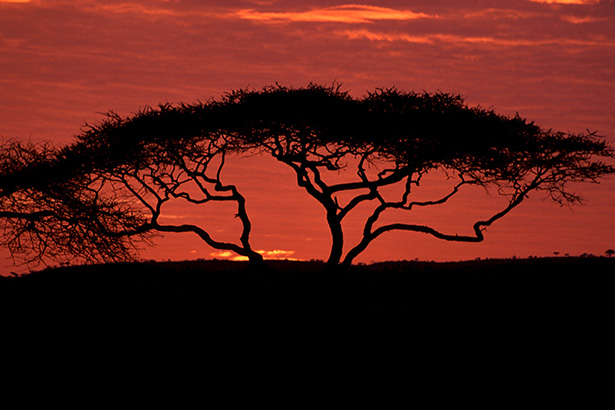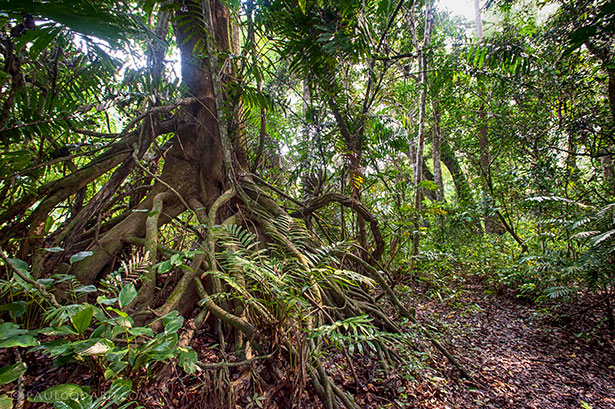Reality and Exoticism in the African Landscape
Excerpt from "Reality and Exoticism in the African Landscape. A Tale of the Disappearing Mirage" by Dismas A. Masolo published in Africa e Mediterraneo n. 83 "Oltre l'albero d'acacia: natura, paesaggio ed ecologia in Africa"
From the journeys of Marco Polo and Vasco da Gama to the slaughter of Cecil the Lion, the taste of the outsider has driven how African landscapes have been painted, literally on canvas and socio-politically and economically in its occupation. These imaginations of the continent have left the impression that Africans themselves either do not exist or do not engage with their habitat in a significant manner. Hence the images of lone, scattered and untouched acacia trees strewn across the savannah idly waiting for the occasional adventurer and discoverer from abroad. I will argue in this paper that Africans have been colluders in bringing about the disappearance of the image of misrepresentation through a variety of activities and failures, both moral and political, that compromise the sustenance of Africa’s environmental integrity and reproductive capacity.
I try to argue in this paper that although the outsider’s view of Africa as a terra nullius persists and drives the manner of engagement with Africans and Africa’s natural resources as part of the global community, it has also caused Africans’ complicity in the destruction of themselves and of their heritage, thus making attribution of ethical and political culpability a tricky enterprise. Ethnic and religious conflicts spurred by sectorial divisions and competitions for socio-economic control of national resources have turned African landscapes into mass graveyards, in some cases transforming previous savannah lands of acacia trees into open fields of skeletons. Not less important is Africans complicity in the destruction of its natural resources, including, but not limited to enabling and aiding the now-storied killing of Cecil the lion in Zimbabwe in the summer of 2015. The poaching of African wildlife is the latest version of the white man’s search for Africa’s exotic natural resources, the attraction that drove European explorers like Marco Polo and Vasco da Gama to sail eastward in search of supplies for the European markets. But this poaching happens with full support and complicity of African political elites, the local accessories to modern global imperialism. Finally, I make observations about modern electronic industry. While it enables Africa to participate in global communication, it is also true that Africa gets the dirty end of this game in opening itself to serving as the dumping ground for Western and now Asian, particularly Chinese industrial relics. Without proper logistics for their safe disposal as these electronic gadgets quickly turn into junks. The African landscape, both rural and urban, is a vast graveyard for human, wild animal, and mechanical bodies, all spewing pollution and further destruction of Africa’s quality of life.
In Who’s interest?
The tale of nature and destructive appetite
European interests in Africa, and in other places farther down the exploratory horizons, were driven by commercial interests and have remained largely so to-date. The accounts narrated in The Travels of Marco Polo attest to these early European-Asian contacts as predominantly based on trade by merchants. The Polos were not the first Europeans to travel to the Far East, but the popularity of Marco Polo’s accounts of the Far East, including India, China, Japan, and many places in-between spread through Europe, certainly helped to spread the excitement and curiosity of many others beyond the circle of merchants. As became the trademark of Europe, soon scholars, especially historians, and missionaries would follow the same or similar paths to expand Europe to the limits of the global map. Exploration, trade, missionary, and political interests often merged their paths or happened in sequence. It would, however, be a little more than two hundred years before another European trade expeditioner, Vasco da Gama, would connect Europe and the Orient, this time by sea, making da Gama the first to achieve that milestone. His voyage, directed at reaching India, would open up the African landmass to European awareness for the first time since the end of the Roman empire’s control of the northern African regions bordering the Mediterranean Sea. Vasco da Gama led Europe’s first successful voyage to India between 1497 and 1499, leaving landmarks at every port where he anchored. These port cities are still dotted with castles or, as they have come to be known, forts, which became centers for amassing supplies and troops to withstand any challenges from competitors. He thus expanded and affirmed Portuguese empire’s control over the trade routes from northern and western African coasts all the way to India across the Indian Ocean. Through him, the routes to Europe’s global imperialism were opened, and Portuguese control over them would remain in place for many decades. Due to their superior military power under the advantage of heavy canons, the Portuguese arrival in the Indian ocean broke the trade between the Persian gulf, mainly the Omani empire, and the East African coast. When slave trade escalated in later years, the forts built by the armies of Vasco da Gama would become holding forts for slaves awaiting transportation to go work in the plantations of the newly found lands in the Caribbeans and Americas. The routes established by da Gama soon attracted the English, French, and Dutch competition. At last, they broke the Venetian monopoly over the legendary spice trade between Europe and Asia that had made the Polo family from Venice so wealthy and famous.
Except where they were met with some suspicion and resistance, such as happened in Mozambique in early 1498 and in Mombasa a few weeks later, these Portuguese intruders saw the ports as doorways to riches that could be accessed by use of military might rather than by conventional market negotiations. Short of direct military power, the Portuguese, and later European trading companies disbursed simple gifts to local rulers and warlords in exchange for their collaboration in providing access to African natural resources and, later, helping to get human captives for the infamous slave trade. Oceanic trade was a free for all terrain where those with bigger canons accessed and took hold of their hauls of spices, gold, slaves, or any other item considered valuable in the trade of the time. Piracy was rampant, thus underlining the emerging idea of Africa as an object of foreigners’ material interest. Nowhere do the narratives include negotiations with African leaders as they were easily conquered and co-opted into the trade that quickly turned into a human tragedy in both its magnitude and nature of treatment of victims. It would be nearly three hundred and thirty years before slave trade was formally abolished by those who had most profited from it, and even much longer before the human and civil rights of Africans would be formally recognized. In fact, and ironically, colonialism, or, the second wave of European scramble for Africa, would start – following the infamous Berlin Conference of 1884-1885 – eighty years after the people of Haiti, an overwhelming majority of them former slaves and subjects of French colonization, had freed themselves from the French yoke in 1804 after forcing the French to announce in 1794 the abolition of slavery and slave holdings in their Caribbean colonies through the unstoppable revolution started in 1791, and some fifty years after the British followed the French in announcing in 1834 the abolition of slavery in their own territories, followed by the Dutch in 1863. What was the ground for the rush to chop up and colonize Africans at home? Descendants of formerly captured and enslaved Africans could be free in the diaspora but Africans could not be free at home.
When Hume criticizes the religion of theists, he fails to address the consistency problem as belonging to humans too. His problem with natural religion, as addressed in the Dialogues concerning Natural Religion,1 was aimed at identifying the inconsistency in believing, like theists do, in a God who is all powerful and benevolent, on the one hand, and, on the other hand, also allows all the evils in the world to happen. How could this god allow pedophiles to exist and have the opportunity to unleash suffering on innocent children? How could this benevolent God allow such maladies like mental illnesses, cancers, polio, smallpox, malaria, and others to exist and to ravage existents like humans, cats, or any other animal causing them such suffering? Or, how could such a God create humans, like Hume himself, with such minds as to be able to philosophize correctly about the nature of human knowledge, and about human inconsistency in believing in this same God, and yet be so unable to see such evil in themselves as to allow them to enslave other some fellow human beings while at the same time talk about and defend the primacy and glory of freedom? The world is full of suffering indeed, but some of it does not have to happen. […]
Dismas A. Masolo is a native of Kenya and teaches philosophy at the University of Louisville, Kentucky. His latest book, Self and Community in a Changing World (2010), has received critical acclaim and was the focus of discussion in a 2014 special issue of the philosophy journal Quest.
Notes
1 – See D. Hume, Dialogues concerning Natural Religion, (eds.) J. C. A. Gaskin, Oxford University Press, New York 1998.

